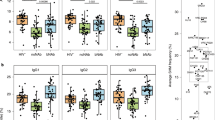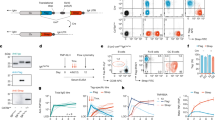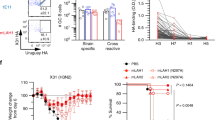Abstract
Immunodominance (ID) defines the hierarchical immune response to competing antigens in complex immunogens. Little is known regarding B cell and antibody ID despite its importance in immunity to viruses and other pathogens. We show that B cells and serum antibodies from inbred mice demonstrate a reproducible ID hierarchy to the five major antigenic sites in the influenza A virus hemagglutinin globular domain. The hierarchy changed as the immune response progressed, and it was dependent on antigen formulation and delivery. Passive antibody transfer and sequential infection experiments demonstrated 'original antigenic suppression', a phenomenon in which antibodies suppress memory responses to the priming antigenic site. Our study provides a template for attaining deeper understanding of antibody ID to viruses and other complex immunogens.
This is a preview of subscription content, access via your institution
Access options
Access Nature and 54 other Nature Portfolio journals
Get Nature+, our best-value online-access subscription
$29.99 / 30 days
cancel any time
Subscribe to this journal
Receive 12 print issues and online access
$209.00 per year
only $17.42 per issue
Buy this article
- Purchase on Springer Link
- Instant access to full article PDF
Prices may be subject to local taxes which are calculated during checkout







Similar content being viewed by others
Accession codes
References
Yewdell, J.W. Confronting complexity: real-world immunodominance in antiviral CD8+ T cell responses. Immunity 25, 533–543 (2006).
Krammer, F. & Palese, P. Advances in the development of influenza virus vaccines. Nat. Rev. Drug Discov. 14, 167–182 (2015).
Burton, D.R., Poignard, P., Stanfield, R.L. & Wilson, I.A. Broadly neutralizing antibodies present new prospects to counter highly antigenically diverse viruses. Science 337, 183–186 (2012).
Wheatley, A.K. & Kent, S.J. Prospects for antibody-based universal influenza vaccines in the context of widespread pre-existing immunity. Expert Rev. Vaccines 14, 1227–1239 (2015).
Victora, G.D. & Wilson, P.C. Germinal center selection and the antibody response to influenza. Cell 163, 545–548 (2015).
Hutchinson, E.C. et al. Conserved and host-specific features of influenza virion architecture. Nat. Commun. 5, 4816 (2014).
Reading, S.A. & Dimmock, N.J. Neutralization of animal virus infectivity by antibody. Arch. Virol. 152, 1047–1059 (2007).
Altman, M.O., Bennink, J.R., Yewdell, J.W. & Herrin, B.R. Lamprey VLRB response to influenza virus supports universal rules of immunogenicity and antigenicity. eLife 4, e07467 (2015).
Caton, A.J., Brownlee, G.G., Yewdell, J.W. & Gerhard, W. The antigenic structure of the influenza virus A/PR/8/34 hemagglutinin (H1 subtype). Cell 31, 417–427 (1982).
Gerhard, W., Yewdell, J., Frankel, M.E. & Webster, R. Antigenic structure of influenza virus hemagglutinin defined by hybridoma antibodies. Nature 290, 713–717 (1981).
Yewdell, J.W., Webster, R.G. & Gerhard, W.U. Antigenic variation in three distinct determinants of an influenza type A hemagglutinin molecule. Nature 279, 246–248 (1979).
Kavaler, J., Caton, A.J., Staudt, L.M., Schwartz, D. & Gerhard, W. A set of closely related antibodies dominates the primary antibody response to the antigenic site CB of the A/PR/8/34 influenza virus hemagglutinin. J. Immunol. 145, 2312–2321 (1990).
McKean, D. et al. Generation of antibody diversity in the immune response of BALB/c mice to influenza virus hemagglutinin. Proc. Natl. Acad. Sci. USA 81, 3180–3184 (1984).
Staudt, L.M. & Gerhard, W. Generation of antibody diversity in the immune response of BALB/c mice to influenza virus hemagglutinin. I. Significant variation in repertoire expression between individual mice. J. Exp. Med. 157, 687–704 (1983).
Das, S.R. et al. Defining influenza A virus hemagglutinin antigenic drift by sequential monoclonal antibody selection. Cell Host Microbe 13, 314–323 (2013).
Lubeck, M. & Gerhard, W. Conformational changes at topologically distinct antigenic sites on the influenza A/PR/8/34 virus HA molecule are induced by the binding of monoclonal antibodies. Virology 118, 1–7 (1982).
Marshall, D., Sealy, R., Sangster, M. & Coleclough, C. TH cells primed during influenza virus infection provide help for qualitatively distinct antibody responses to subsequent immunization. J. Immunol. 163, 4673–4682 (1999).
Rothaeusler, K. & Baumgarth, N. B cell fate decisions following influenza virus infection. Eur. J. Immunol. 40, 366–377 (2010).
Sealy, R., Surman, S., Hurwitz, J.L. & Coleclough, C. Antibody response to influenza infection of mice: different patterns for glycoprotein and nucleocapsid antigens. Immunology 108, 431–439 (2003).
Baumgarth, N. How specific is too specific? B cell responses to viral infections reveal the importance of breadth over depth. Immunol. Rev. 255, 82–94 (2013).
Whittle, J.R. et al. Flow cytometry reveals that H5N1 vaccination elicits cross-reactive stem-directed antibodies from multiple Ig heavy-chain lineages. J. Virol. 88, 4047–4057 (2014).
Frank, G.M. et al. A simple flow-cytometric method measuring B cell surface immunoglobulin avidity enables characterization of affinity maturation to influenza A virus. MBio 6, e01156 (2015).
Tsilibary, E.C. & Wissig, S.L. Light and electron microscope observations of the lymphatic drainage units of the peritoneal cavity of rodents. Am. J. Anat. 180, 195–207 (1987).
Lee, B.O. et al. CD4 T cell–independent antibody response promotes resolution of primary influenza infection and helps to prevent reinfection. J. Immunol. 175, 5827–5838 (2005).
Mozdzanowska, K., Furchner, M., Zharikova, D., Feng, J. & Gerhard, W. Roles of CD4+ T cell–independent and T cell–dependent antibody responses in the control of influenza virus infection: evidence for noncognate CD4+ T cell activities that enhance the therapeutic activity of antiviral antibodies. J. Virol. 79, 5943–5951 (2005).
Hai, R. et al. Influenza viruses expressing chimeric hemagglutinins: globular head and stalk domains derived from different subtypes. J. Virol. 86, 5774–5781 (2012).
Bennink, J.R. & Doherty, P.C. The response to H-2-different virus-infected cells is mediated by long-lived T lymphocytes and is diminished by prior virus priming in a syngeneic environment. Cell. Immunol. 61, 220–224 (1981).
Jamieson, B.D. & Ahmed, R. T cell memory. Long-term persistence of virus-specific cytotoxic T cells. J. Exp. Med. 169, 1993–2005 (1989).
Kim, J.H., Skountzou, I., Compans, R. & Jacob, J. Original antigenic sin responses to influenza viruses. J. Immunol. 183, 3294–3301 (2009).
Kavaler, J., Caton, A.J., Staudt, L.M. & Gerhard, W. A B cell population that dominates the primary response to influenza virus hemagglutinin does not participate in the memory response. Eur. J. Immunol. 21, 2687–2695 (1991).
Churchill, G.A. et al. The Collaborative Cross, a community resource for the genetic analysis of complex traits. Nat. Genet. 36, 1133–1137 (2004).
Linderman, S.L. et al. Potential antigenic explanation for atypical H1N1 infections among middle-aged adults during the 2013–2014 influenza season. Proc. Natl. Acad. Sci. USA 111, 15798–15803 (2014).
Jelley-Gibbs, D.M. et al. Unexpected prolonged presentation of influenza antigens promotes CD4 T cell memory generation. J. Exp. Med. 202, 697–706 (2005).
Waffarn, E.E. & Baumgarth, N. Protective B cell responses to flu—no fluke! J. Immunol. 186, 3823–3829 (2011).
MacLennan, I.C.M. Germinal centers. Annu. Rev. Immunol. 12, 117–139 (1994).
Hollowood, K. & Macartney, J. Cell kinetics of the germinal center reaction—a stathmokinetic study. Eur. J. Immunol. 22, 261–266 (1992).
Zammit, D.J., Turner, D.L., Klonowski, K.D., Lefrançois, L. & Cauley, L.S. Residual antigen presentation after influenza virus infection affects CD8 T cell activation and migration. Immunity 24, 439–449 (2006).
Webster, R.G., Fazekas de St.Groth, S. & Webster, R.G. Disquisition on original antigenic sin. I. Evidence in man. J. Exp. Med. 124, 331–345 (1966).
Kim, J.H., Davis, W.G., Sambhara, S. & Jacob, J. Strategies to alleviate original antigenic sin responses to influenza viruses. Proc. Natl. Acad. Sci. USA 109, 13751–13756 (2012).
Andrews, S.F. et al. High pre-existing serological antibody levels correlate with diversification of the influenza vaccine response. J. Virol. 89, 3308–3317 (2015).
Sasaki, S. et al. Influence of prior influenza vaccination on antibody and B cell responses. PLoS One 3, e2975 (2008).
Fleishman, S.J. et al. Computational design of proteins targeting the conserved stem region of influenza hemagglutinin. Science 332, 816–821 (2011).
Gamblin, S.J. et al. The structure and receptor binding properties of the 1918 influenza hemagglutinin. Science 303, 1838–1842 (2004).
Yewdell, J.W. & Gerhard, W. Antigenic characterization of viruses by monoclonal antibodies. Annu. Rev. Microbiol. 35, 185–206 (1981).
Pieri, L., Sassoli, C., Romagnoli, P. & Domenici, L. Use of periodate–lysine–paraformaldehyde for the fixation of multiple antigens in human skin biopsies. Eur. J. Histochem. 46, 365–375 (2002).
Acknowledgements
We thank the NIAID Comparative Medicine Branch for maintaining the mice used in this study, and P. Palese and F. Krammer (Icahn School of Medicine at Mount Sinai) for the chimeric HA virus construct. Supported by the Division of Intramural Research, National Institute of Allergy and Infectious Diseases (J.W.Y. and A.B.M.).
Author information
Authors and Affiliations
Contributions
D.A. designed and performed experiments, analyzed data and wrote the paper; J.S.G., M.A., I.K., H.D.H., G.M.F. and S.R.D. designed and performed experiments and analyzed data; A.K.W., M.P., D.J.L. and A.B.M. designed and generated critical reagents for the study; and J.W.Y. designed experiments, analyzed data and wrote the paper. All authors provided useful comments on the manuscript.
Corresponding author
Ethics declarations
Competing interests
The authors declare no competing financial interests.
Integrated supplementary information
Supplementary Figure 1 Quantification of the virus-purified HAs and their specificities.
(a) Sera from two individual i.n. infected guinea pigs were absorbed on the viruses indicated on the X axis. The depleted sera was tested for its capacity to block binding of site-specific Fabs. The results are presented as relative binding inhibition, where binding of Fab to PR8 virus pre incubated with neat serum equals 100% and binding inhibition to virus with no competing serum is zero. Results are from three technical replicates of two individual guinea pigs. Columns represent means and SEM (bars). (b) ELISA comparison between the virus-purified HAs and rHA showing accurate quantification of the purified glycoproteins. Results are normalized to PR8 AUC set as 100%. Columns represent mean and SEM (bars) of 5 distinct sera. We also used total protein amount, Coomassie staining, western blotting, head-specific mAbs and anti-stem mAbs (not shown) to confirm that similar amounts of antigen were used in ELISA assays for all PR8 derived HAs.
Supplementary Figure 2 Gating strategy and specificity of rHA probes.
We infected mice i.n. with 50 TCID50 PR8. (a) Flow plot depicting gating strategy to identify GC B cells based on live/dead EMA- and CD3ɛ- B220+ CD38- GL7+ surface expression. Only GC B cells specifically bind rHA. (b) The dot plot depicts one representative experiment showing the % of GC B cells that are stained by the recombinant probes. Shown is one representative example of three independent experiments with 5 pooled mice each (for both a and b). (c) We infected mice were i.n. with 50 TCID50 of either PR8 or J1, a reassortant virus with all the gene segments from PR8 except for segment 4 encoding H3 HA. At 28 d p.i, we pooled MLN from 5 infected mice and stained as above. Shown are results at 28 d.p.i. of three independent experiments with 5 mice pooled each (PR8) or one experiment with 5 mice pooled (J1).Columns represent means and SEM (bars). (d) Bar graph showing cumulative MLN GC B cell responses. After S12 AUC subtraction, the sum of the B cell frequency to the 5 antigenic sites is similar to the PR8 response. Columns represent means and SEM (bars).
Supplementary Figure 3 Heavy-chain composition of immune sera.
We infected mice infected i.n. with 50 TCID50 PR8. The sera analyzed in Figure 2C were subjected to heavy chain ELISA to determine the proportion of antigenic site-specific IgG (filled bars) vs. IgM (striped bars). Columns represent means and SEM (bars).
Supplementary Figure 4 Splenic B cell kinetics and immunodominance in IAV-infected and immunized mice.
(a) Bar graph showing the frequency of antigenic site-specific germinal center B cells at different d.p.i. S12 frequencies were considered baseline and subtracted from PR8 and Δ4 values. Column represent mean and SEM (bars). Shown are three independent experiments with three pooled spleens each. (b) Scatter plot showing the correlation between ELISA recognition of the different HAs (Fig. 2c) and frequency of splenic GC B cells P=0.4319 r=0.1976. Dashed lines are 95% confidence intervals. Scatter plots showing the correlation between ELISA recognition of different HAs (Fig. 2c) and the different cell numbers. Data is the same presented in Fig. 2b and Supplementary Fig. 3a but expressed as total number of cells in the MLN P<0.0001 r=0.8095 (c), spleen P=0.0838 r=0.4186 (d) or total cell number (MLN+spleen) P=0.0001 r=0.7865 (e). Circles represent 14 d p.i., squares, 21 d p.i. and triangles, 28 d p.i.. Dashed lines represent 95% confidence intervals. (f) We immunized mice i.p. with 2500 HAU of UV-inactivated PR8. Scatter plot shows correlation between the frequency of MLN versus splenic GC B cells. P<0.0001 r=0.9941. Shown is the average from two independent experiments with five pooled mice each.
Supplementary Figure 5 CD4+ T cell depletion.
We depleted CD4+ T cells as described in Fig. 4. Shown are representative flow cytometry plots showing CD4+ and CD8+ T cells (gated on live, CD3+, B220-) (a) and GC B cells (gated on live, CD3-, B220+) (b) in untreated versus CD4-depleted animal at 14 d.p.i.. (c) LN sectioning and immunofluorescent staining comparing GC formation in untreated versus CD4-depleted animals in LN following i.n. infection and spleen following i.p. immunization. Representative flow cytometry of one spleen from two independent experiments with five and three mice per group (a), one spleen from one experiment with three mice per group (b). Representative microscopy of one spleen from one experiment with three mice per group (c)
Supplementary Figure 6 Δ4 virus infection generates Abs specific to the intact antigenic site.
(a) ELISA results showing the reactivity of Δ4 infected animals (from Fig. 6) on PR8 HA (Δ infected) and the reactivity of PR8 infected animals on Δ4 and S12 (PR8 infected). Column represent mean and bars SEM (n=4 for PR8, Sa, Ca1, Ca2; n=5 for Cb and n=8 for Sb). (b) Correlation between the AUC values presented in A. P=0.0105 r=0.9573. Dashed lines are 95% confidence intervals.
Supplementary Figure 7 Pre-existing Abs influence recall responses.
We infected mice i.n. with 50 TCID50 Δ4Sb or Δ4Cb virus and challenged at 28 d.p.i. i.p. with 2000 HAU of PR8. We collected sera 7 d post challenge and tested by ELISA for binding to PR8, Δ4 and S12 HAs. The data are the same as Fig. 7c, but shown is the serum response to all antigenic sites 28 d after infection and 7 d after i.p. challenge. Arrows indicate the site corresponding to the primary virus. Data on graph represent mean and SEM (bars) of two independent experiments with 3 mice each.
Supplementary information
Supplementary Text and Figures
Supplementary Figures 1–7 and Supplementary Tables 1–3 (PDF 1616 kb)
Rights and permissions
About this article
Cite this article
Angeletti, D., Gibbs, J., Angel, M. et al. Defining B cell immunodominance to viruses. Nat Immunol 18, 456–463 (2017). https://doi.org/10.1038/ni.3680
Received:
Accepted:
Published:
Issue Date:
DOI: https://doi.org/10.1038/ni.3680
This article is cited by
-
Applying valency-based immuno-selection to generate broadly cross-reactive antibodies against influenza hemagglutinins
Nature Communications (2024)
-
Beyond neutralization: Fc-dependent antibody effector functions in SARS-CoV-2 infection
Nature Reviews Immunology (2023)
-
Sequential vaccinations with divergent H1N1 influenza virus strains induce multi-H1 clade neutralizing antibodies in swine
Nature Communications (2023)
-
CD4 T cell epitope abundance in ferritin core potentiates responses to hemagglutinin nanoparticle vaccines
npj Vaccines (2022)
-
TLR agonists induce sustained IgG to hemagglutinin stem and modulate T cells following newborn vaccination
npj Vaccines (2022)



